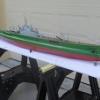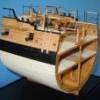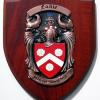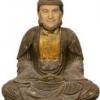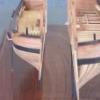-
Posts
3,084 -
Joined
-
Last visited
Reputation Activity
-
 Jaager got a reaction from Salty Sea Dog in Licorne 1755 by mtaylor - 3/16" scale - French Frigate - from Hahn plans - Version 2.0 - TERMINATED
Jaager got a reaction from Salty Sea Dog in Licorne 1755 by mtaylor - 3/16" scale - French Frigate - from Hahn plans - Version 2.0 - TERMINATED
Something to consider for keeping carving tools sharp:
Get some pieces of scrap leather from a local shop that works leather.
Coat the smooth side with Flexcut Gold Polishing compd.
It comes as a stick - use like a crayon to coat the leather.
Strop the edge frequently - pull the blade.
I must sometimes move the blade slightly in the cutting direction when I place it on the leather - I can tell because it messes up the surface of the leather. Several back up pieces of leather is useful to have.
Unless you mar the edge of the tool by hitting steel or something, you should not need to use a sharpening stone ever again. Stropping should be enough.
-
 Jaager got a reaction from Canute in finish for wood
Jaager got a reaction from Canute in finish for wood
For a deck, I skip the Tung oil and use only shellac. It is easy enough to buff the surface if it is too glossy.
Shellac is the classic base for most any other non water based finish - paint or clear.
I haven't gotten there, since I found out about it, but I think the last layer will be a rubbed on coat of Renaissance wax.
I doubt the process would be very interesting as a pictorial.
One promising thing - I finally got a picture that I can look at from my digital camera. It was the first I took from a distance and not macro. Who knew? It is the midship section framing of USS Porpoise 1836 - designed as a schooner - rigged as a brigantine and later a brig -
The last few years, I have been developing a (new?) way of framing a hull that I call The Frame Sandwich Method. I am just not sure how to present it.
-
 Jaager got a reaction from Piet in Licorne 1755 by mtaylor - 3/16" scale - French Frigate - from Hahn plans - Version 2.0 - TERMINATED
Jaager got a reaction from Piet in Licorne 1755 by mtaylor - 3/16" scale - French Frigate - from Hahn plans - Version 2.0 - TERMINATED
Something to consider for keeping carving tools sharp:
Get some pieces of scrap leather from a local shop that works leather.
Coat the smooth side with Flexcut Gold Polishing compd.
It comes as a stick - use like a crayon to coat the leather.
Strop the edge frequently - pull the blade.
I must sometimes move the blade slightly in the cutting direction when I place it on the leather - I can tell because it messes up the surface of the leather. Several back up pieces of leather is useful to have.
Unless you mar the edge of the tool by hitting steel or something, you should not need to use a sharpening stone ever again. Stropping should be enough.
-
 Jaager got a reaction from mtaylor in finish for wood
Jaager got a reaction from mtaylor in finish for wood
For a deck, I skip the Tung oil and use only shellac. It is easy enough to buff the surface if it is too glossy.
Shellac is the classic base for most any other non water based finish - paint or clear.
I haven't gotten there, since I found out about it, but I think the last layer will be a rubbed on coat of Renaissance wax.
I doubt the process would be very interesting as a pictorial.
One promising thing - I finally got a picture that I can look at from my digital camera. It was the first I took from a distance and not macro. Who knew? It is the midship section framing of USS Porpoise 1836 - designed as a schooner - rigged as a brigantine and later a brig -
The last few years, I have been developing a (new?) way of framing a hull that I call The Frame Sandwich Method. I am just not sure how to present it.
-
 Jaager got a reaction from mtaylor in finish for wood
Jaager got a reaction from mtaylor in finish for wood
Flying my true colors, I have a bias against plastic or anything synthetic on my wooden ship models. This does not extend as any prejudice against the work of others who do use these products
raw wood - sanded 220 -> 320 -> 400 -> 600 and then scraped with single edged razor blade - rubbed with shammy leather cloth
1st coat pure Tung oil cut 1:1 with mineral spirits.
2nd coat straight Tung oil.
3rd coat super blonde shellac flakes made into a 5% solution in 100% 2-propanol (isopropyl alcohol) [ 10% solution diluted 1:1 ]
4th coat 10% shellac.
0000 steel wool between coats. Be sure to remove all of the steel fragments - they will oxidize and stain the wood.
-
 Jaager got a reaction from dvm27 in Licorne 1755 by mtaylor - 3/16" scale - French Frigate - from Hahn plans - Version 2.0 - TERMINATED
Jaager got a reaction from dvm27 in Licorne 1755 by mtaylor - 3/16" scale - French Frigate - from Hahn plans - Version 2.0 - TERMINATED
Something to consider for keeping carving tools sharp:
Get some pieces of scrap leather from a local shop that works leather.
Coat the smooth side with Flexcut Gold Polishing compd.
It comes as a stick - use like a crayon to coat the leather.
Strop the edge frequently - pull the blade.
I must sometimes move the blade slightly in the cutting direction when I place it on the leather - I can tell because it messes up the surface of the leather. Several back up pieces of leather is useful to have.
Unless you mar the edge of the tool by hitting steel or something, you should not need to use a sharpening stone ever again. Stropping should be enough.
-
 Jaager got a reaction from mtaylor in Licorne 1755 by mtaylor - 3/16" scale - French Frigate - from Hahn plans - Version 2.0 - TERMINATED
Jaager got a reaction from mtaylor in Licorne 1755 by mtaylor - 3/16" scale - French Frigate - from Hahn plans - Version 2.0 - TERMINATED
Something to consider for keeping carving tools sharp:
Get some pieces of scrap leather from a local shop that works leather.
Coat the smooth side with Flexcut Gold Polishing compd.
It comes as a stick - use like a crayon to coat the leather.
Strop the edge frequently - pull the blade.
I must sometimes move the blade slightly in the cutting direction when I place it on the leather - I can tell because it messes up the surface of the leather. Several back up pieces of leather is useful to have.
Unless you mar the edge of the tool by hitting steel or something, you should not need to use a sharpening stone ever again. Stropping should be enough.
-
 Jaager got a reaction from src in Licorne 1755 by mtaylor - 3/16" scale - French Frigate - from Hahn plans - Version 2.0 - TERMINATED
Jaager got a reaction from src in Licorne 1755 by mtaylor - 3/16" scale - French Frigate - from Hahn plans - Version 2.0 - TERMINATED
Something to consider for keeping carving tools sharp:
Get some pieces of scrap leather from a local shop that works leather.
Coat the smooth side with Flexcut Gold Polishing compd.
It comes as a stick - use like a crayon to coat the leather.
Strop the edge frequently - pull the blade.
I must sometimes move the blade slightly in the cutting direction when I place it on the leather - I can tell because it messes up the surface of the leather. Several back up pieces of leather is useful to have.
Unless you mar the edge of the tool by hitting steel or something, you should not need to use a sharpening stone ever again. Stropping should be enough.
-
 Jaager got a reaction from Jack12477 in Licorne 1755 by mtaylor - 3/16" scale - French Frigate - from Hahn plans - Version 2.0 - TERMINATED
Jaager got a reaction from Jack12477 in Licorne 1755 by mtaylor - 3/16" scale - French Frigate - from Hahn plans - Version 2.0 - TERMINATED
Something to consider for keeping carving tools sharp:
Get some pieces of scrap leather from a local shop that works leather.
Coat the smooth side with Flexcut Gold Polishing compd.
It comes as a stick - use like a crayon to coat the leather.
Strop the edge frequently - pull the blade.
I must sometimes move the blade slightly in the cutting direction when I place it on the leather - I can tell because it messes up the surface of the leather. Several back up pieces of leather is useful to have.
Unless you mar the edge of the tool by hitting steel or something, you should not need to use a sharpening stone ever again. Stropping should be enough.
-
 Jaager got a reaction from augie in Licorne 1755 by mtaylor - 3/16" scale - French Frigate - from Hahn plans - Version 2.0 - TERMINATED
Jaager got a reaction from augie in Licorne 1755 by mtaylor - 3/16" scale - French Frigate - from Hahn plans - Version 2.0 - TERMINATED
Something to consider for keeping carving tools sharp:
Get some pieces of scrap leather from a local shop that works leather.
Coat the smooth side with Flexcut Gold Polishing compd.
It comes as a stick - use like a crayon to coat the leather.
Strop the edge frequently - pull the blade.
I must sometimes move the blade slightly in the cutting direction when I place it on the leather - I can tell because it messes up the surface of the leather. Several back up pieces of leather is useful to have.
Unless you mar the edge of the tool by hitting steel or something, you should not need to use a sharpening stone ever again. Stropping should be enough.
-
 Jaager got a reaction from GLakie in Licorne 1755 by mtaylor - 3/16" scale - French Frigate - from Hahn plans - Version 2.0 - TERMINATED
Jaager got a reaction from GLakie in Licorne 1755 by mtaylor - 3/16" scale - French Frigate - from Hahn plans - Version 2.0 - TERMINATED
Something to consider for keeping carving tools sharp:
Get some pieces of scrap leather from a local shop that works leather.
Coat the smooth side with Flexcut Gold Polishing compd.
It comes as a stick - use like a crayon to coat the leather.
Strop the edge frequently - pull the blade.
I must sometimes move the blade slightly in the cutting direction when I place it on the leather - I can tell because it messes up the surface of the leather. Several back up pieces of leather is useful to have.
Unless you mar the edge of the tool by hitting steel or something, you should not need to use a sharpening stone ever again. Stropping should be enough.
-
 Jaager got a reaction from Canute in Licorne 1755 by mtaylor - 3/16" scale - French Frigate - from Hahn plans - Version 2.0 - TERMINATED
Jaager got a reaction from Canute in Licorne 1755 by mtaylor - 3/16" scale - French Frigate - from Hahn plans - Version 2.0 - TERMINATED
Something to consider for keeping carving tools sharp:
Get some pieces of scrap leather from a local shop that works leather.
Coat the smooth side with Flexcut Gold Polishing compd.
It comes as a stick - use like a crayon to coat the leather.
Strop the edge frequently - pull the blade.
I must sometimes move the blade slightly in the cutting direction when I place it on the leather - I can tell because it messes up the surface of the leather. Several back up pieces of leather is useful to have.
Unless you mar the edge of the tool by hitting steel or something, you should not need to use a sharpening stone ever again. Stropping should be enough.
-
 Jaager got a reaction from WackoWolf in Licorne 1755 by mtaylor - 3/16" scale - French Frigate - from Hahn plans - Version 2.0 - TERMINATED
Jaager got a reaction from WackoWolf in Licorne 1755 by mtaylor - 3/16" scale - French Frigate - from Hahn plans - Version 2.0 - TERMINATED
Something to consider for keeping carving tools sharp:
Get some pieces of scrap leather from a local shop that works leather.
Coat the smooth side with Flexcut Gold Polishing compd.
It comes as a stick - use like a crayon to coat the leather.
Strop the edge frequently - pull the blade.
I must sometimes move the blade slightly in the cutting direction when I place it on the leather - I can tell because it messes up the surface of the leather. Several back up pieces of leather is useful to have.
Unless you mar the edge of the tool by hitting steel or something, you should not need to use a sharpening stone ever again. Stropping should be enough.
-
 Jaager got a reaction from mtaylor in Practicing lofting frames - any feedback?
Jaager got a reaction from mtaylor in Practicing lofting frames - any feedback?
Suggestions:
Draw your grid on the white side of a piece of thick poster board.
Tape a piece of transparent drafting velum or a less expensive substitute:
Bienfang Designer Grid Paper, 50 Sheets, 8-1/2-Inch by 11-Inch Pad, 8 by 8 Cross Section
( $7.00 at Amazon ) The lines are straight and the grid perpendicular, but the grid is not precise.
The center line, keel line and base line transferred , but you can leave off the waterlines and buttock lines for each frame - just the frame points are needed.
Only plot one side of the frame.
Scan the half frame into your computer.
Have a transparent metric ruler in the scan.
Open the scan in a drawing program - Photo Shop - ( has a rental online deal - if you are quick, you only need a 1 month rental) / Paint Shop Pro / I use Painter 12 - older versions like Painter 8 work just as well - I just needed 12 to get PNG in/out.
The program needs layers.
Open the half frame as a layer, duplicate it, flip copy horizontally and position the baseline/ centerline and combine the two layers. You now have a precise mirror of the half frame.
Kate Cory would probably be framed French/American style - paired frames with the space between +/- half the thickness of one of the pair. I round - I am working on USS Vincennes 1825 R/S is 26" Given the range of sided dimensions of the frames I chose to make each frame 10" and the space 6".
The point ? You can use the middle frame shape layer for both outlines of the pair.
The metric ruler part - scan in - print out - can be altered by the computer- Matching up the print out of the ruler with the ruler- the % change in document size needed to be done in the drawing program to get identity in size is easier to calculate using metric an English scale.
Another advantage - colored lines are easier to follow when cutting out and shaping the frames. With a paint program, it is easy to magic wand a line and change its color.
I make the dead flat centerline shape = red - next one = green, the next one = blue, the next = red....
The paint program color picker has a slider for each of the three colors, so they are easy to set -
255/0/0 then 0/255/0 then 0/0/255.
-
 Jaager got a reaction from hamilton in Practicing lofting frames - any feedback?
Jaager got a reaction from hamilton in Practicing lofting frames - any feedback?
Suggestions:
Draw your grid on the white side of a piece of thick poster board.
Tape a piece of transparent drafting velum or a less expensive substitute:
Bienfang Designer Grid Paper, 50 Sheets, 8-1/2-Inch by 11-Inch Pad, 8 by 8 Cross Section
( $7.00 at Amazon ) The lines are straight and the grid perpendicular, but the grid is not precise.
The center line, keel line and base line transferred , but you can leave off the waterlines and buttock lines for each frame - just the frame points are needed.
Only plot one side of the frame.
Scan the half frame into your computer.
Have a transparent metric ruler in the scan.
Open the scan in a drawing program - Photo Shop - ( has a rental online deal - if you are quick, you only need a 1 month rental) / Paint Shop Pro / I use Painter 12 - older versions like Painter 8 work just as well - I just needed 12 to get PNG in/out.
The program needs layers.
Open the half frame as a layer, duplicate it, flip copy horizontally and position the baseline/ centerline and combine the two layers. You now have a precise mirror of the half frame.
Kate Cory would probably be framed French/American style - paired frames with the space between +/- half the thickness of one of the pair. I round - I am working on USS Vincennes 1825 R/S is 26" Given the range of sided dimensions of the frames I chose to make each frame 10" and the space 6".
The point ? You can use the middle frame shape layer for both outlines of the pair.
The metric ruler part - scan in - print out - can be altered by the computer- Matching up the print out of the ruler with the ruler- the % change in document size needed to be done in the drawing program to get identity in size is easier to calculate using metric an English scale.
Another advantage - colored lines are easier to follow when cutting out and shaping the frames. With a paint program, it is easy to magic wand a line and change its color.
I make the dead flat centerline shape = red - next one = green, the next one = blue, the next = red....
The paint program color picker has a slider for each of the three colors, so they are easy to set -
255/0/0 then 0/255/0 then 0/0/255.
-
 Jaager got a reaction from Canute in Practicing lofting frames - any feedback?
Jaager got a reaction from Canute in Practicing lofting frames - any feedback?
Suggestions:
Draw your grid on the white side of a piece of thick poster board.
Tape a piece of transparent drafting velum or a less expensive substitute:
Bienfang Designer Grid Paper, 50 Sheets, 8-1/2-Inch by 11-Inch Pad, 8 by 8 Cross Section
( $7.00 at Amazon ) The lines are straight and the grid perpendicular, but the grid is not precise.
The center line, keel line and base line transferred , but you can leave off the waterlines and buttock lines for each frame - just the frame points are needed.
Only plot one side of the frame.
Scan the half frame into your computer.
Have a transparent metric ruler in the scan.
Open the scan in a drawing program - Photo Shop - ( has a rental online deal - if you are quick, you only need a 1 month rental) / Paint Shop Pro / I use Painter 12 - older versions like Painter 8 work just as well - I just needed 12 to get PNG in/out.
The program needs layers.
Open the half frame as a layer, duplicate it, flip copy horizontally and position the baseline/ centerline and combine the two layers. You now have a precise mirror of the half frame.
Kate Cory would probably be framed French/American style - paired frames with the space between +/- half the thickness of one of the pair. I round - I am working on USS Vincennes 1825 R/S is 26" Given the range of sided dimensions of the frames I chose to make each frame 10" and the space 6".
The point ? You can use the middle frame shape layer for both outlines of the pair.
The metric ruler part - scan in - print out - can be altered by the computer- Matching up the print out of the ruler with the ruler- the % change in document size needed to be done in the drawing program to get identity in size is easier to calculate using metric an English scale.
Another advantage - colored lines are easier to follow when cutting out and shaping the frames. With a paint program, it is easy to magic wand a line and change its color.
I make the dead flat centerline shape = red - next one = green, the next one = blue, the next = red....
The paint program color picker has a slider for each of the three colors, so they are easy to set -
255/0/0 then 0/255/0 then 0/0/255.
-
 Jaager got a reaction from tkay11 in Practicing lofting frames - any feedback?
Jaager got a reaction from tkay11 in Practicing lofting frames - any feedback?
Suggestions:
Draw your grid on the white side of a piece of thick poster board.
Tape a piece of transparent drafting velum or a less expensive substitute:
Bienfang Designer Grid Paper, 50 Sheets, 8-1/2-Inch by 11-Inch Pad, 8 by 8 Cross Section
( $7.00 at Amazon ) The lines are straight and the grid perpendicular, but the grid is not precise.
The center line, keel line and base line transferred , but you can leave off the waterlines and buttock lines for each frame - just the frame points are needed.
Only plot one side of the frame.
Scan the half frame into your computer.
Have a transparent metric ruler in the scan.
Open the scan in a drawing program - Photo Shop - ( has a rental online deal - if you are quick, you only need a 1 month rental) / Paint Shop Pro / I use Painter 12 - older versions like Painter 8 work just as well - I just needed 12 to get PNG in/out.
The program needs layers.
Open the half frame as a layer, duplicate it, flip copy horizontally and position the baseline/ centerline and combine the two layers. You now have a precise mirror of the half frame.
Kate Cory would probably be framed French/American style - paired frames with the space between +/- half the thickness of one of the pair. I round - I am working on USS Vincennes 1825 R/S is 26" Given the range of sided dimensions of the frames I chose to make each frame 10" and the space 6".
The point ? You can use the middle frame shape layer for both outlines of the pair.
The metric ruler part - scan in - print out - can be altered by the computer- Matching up the print out of the ruler with the ruler- the % change in document size needed to be done in the drawing program to get identity in size is easier to calculate using metric an English scale.
Another advantage - colored lines are easier to follow when cutting out and shaping the frames. With a paint program, it is easy to magic wand a line and change its color.
I make the dead flat centerline shape = red - next one = green, the next one = blue, the next = red....
The paint program color picker has a slider for each of the three colors, so they are easy to set -
255/0/0 then 0/255/0 then 0/0/255.
-
 Jaager got a reaction from dgbot in Practicing lofting frames - any feedback?
Jaager got a reaction from dgbot in Practicing lofting frames - any feedback?
Suggestions:
Draw your grid on the white side of a piece of thick poster board.
Tape a piece of transparent drafting velum or a less expensive substitute:
Bienfang Designer Grid Paper, 50 Sheets, 8-1/2-Inch by 11-Inch Pad, 8 by 8 Cross Section
( $7.00 at Amazon ) The lines are straight and the grid perpendicular, but the grid is not precise.
The center line, keel line and base line transferred , but you can leave off the waterlines and buttock lines for each frame - just the frame points are needed.
Only plot one side of the frame.
Scan the half frame into your computer.
Have a transparent metric ruler in the scan.
Open the scan in a drawing program - Photo Shop - ( has a rental online deal - if you are quick, you only need a 1 month rental) / Paint Shop Pro / I use Painter 12 - older versions like Painter 8 work just as well - I just needed 12 to get PNG in/out.
The program needs layers.
Open the half frame as a layer, duplicate it, flip copy horizontally and position the baseline/ centerline and combine the two layers. You now have a precise mirror of the half frame.
Kate Cory would probably be framed French/American style - paired frames with the space between +/- half the thickness of one of the pair. I round - I am working on USS Vincennes 1825 R/S is 26" Given the range of sided dimensions of the frames I chose to make each frame 10" and the space 6".
The point ? You can use the middle frame shape layer for both outlines of the pair.
The metric ruler part - scan in - print out - can be altered by the computer- Matching up the print out of the ruler with the ruler- the % change in document size needed to be done in the drawing program to get identity in size is easier to calculate using metric an English scale.
Another advantage - colored lines are easier to follow when cutting out and shaping the frames. With a paint program, it is easy to magic wand a line and change its color.
I make the dead flat centerline shape = red - next one = green, the next one = blue, the next = red....
The paint program color picker has a slider for each of the three colors, so they are easy to set -
255/0/0 then 0/255/0 then 0/0/255.
-
 Jaager got a reaction from mtaylor in General / organisation of wood
Jaager got a reaction from mtaylor in General / organisation of wood
For city dwellers, a possible source of stock lumber = your local tree service companies. I think the wood is mostly junk to them, something they have to dispose of. You may be able to get some interesting stock for little or no cost.
-
 Jaager got a reaction from Canute in Mast and Spar replacements
Jaager got a reaction from Canute in Mast and Spar replacements
Dowels are generally a problem as a source for stock for masts and spars. It is usually an accident for the grain to be straight. When cut free, they will seek an equilibrium point over time and that can be a curved state.
A way to avoid this is to start with plank stock of a straight grained / closed pore species of wood and split the spar stock out along the natural grain. The hope is that this will be the equilibrium position as Time and Environment act on the piece of wood.
The tool designed to do this is a froe. A full sized froe is used to produce things like Cedar shakes. There is a smaller version that I have been looking at, but do not own yet:
http://www.japanwoodworker.com/Product/156564/Bamboo-Froe-%28Take-Wari%29---Ikeuti.aspx
In most locations a species of Acer (Maple) should be available locally from hardwood dealers.
White Pine (Sugar / Pattern makers)
Yellow Poplar
Beech or Birch
-
 Jaager got a reaction from thibaultron in Mast and Spar replacements
Jaager got a reaction from thibaultron in Mast and Spar replacements
Dowels are generally a problem as a source for stock for masts and spars. It is usually an accident for the grain to be straight. When cut free, they will seek an equilibrium point over time and that can be a curved state.
A way to avoid this is to start with plank stock of a straight grained / closed pore species of wood and split the spar stock out along the natural grain. The hope is that this will be the equilibrium position as Time and Environment act on the piece of wood.
The tool designed to do this is a froe. A full sized froe is used to produce things like Cedar shakes. There is a smaller version that I have been looking at, but do not own yet:
http://www.japanwoodworker.com/Product/156564/Bamboo-Froe-%28Take-Wari%29---Ikeuti.aspx
In most locations a species of Acer (Maple) should be available locally from hardwood dealers.
White Pine (Sugar / Pattern makers)
Yellow Poplar
Beech or Birch
-
 Jaager got a reaction from qwerty2008 in Mast and Spar replacements
Jaager got a reaction from qwerty2008 in Mast and Spar replacements
Dowels are generally a problem as a source for stock for masts and spars. It is usually an accident for the grain to be straight. When cut free, they will seek an equilibrium point over time and that can be a curved state.
A way to avoid this is to start with plank stock of a straight grained / closed pore species of wood and split the spar stock out along the natural grain. The hope is that this will be the equilibrium position as Time and Environment act on the piece of wood.
The tool designed to do this is a froe. A full sized froe is used to produce things like Cedar shakes. There is a smaller version that I have been looking at, but do not own yet:
http://www.japanwoodworker.com/Product/156564/Bamboo-Froe-%28Take-Wari%29---Ikeuti.aspx
In most locations a species of Acer (Maple) should be available locally from hardwood dealers.
White Pine (Sugar / Pattern makers)
Yellow Poplar
Beech or Birch
-
 Jaager got a reaction from thomaslambo in Mast and Spar replacements
Jaager got a reaction from thomaslambo in Mast and Spar replacements
Dowels are generally a problem as a source for stock for masts and spars. It is usually an accident for the grain to be straight. When cut free, they will seek an equilibrium point over time and that can be a curved state.
A way to avoid this is to start with plank stock of a straight grained / closed pore species of wood and split the spar stock out along the natural grain. The hope is that this will be the equilibrium position as Time and Environment act on the piece of wood.
The tool designed to do this is a froe. A full sized froe is used to produce things like Cedar shakes. There is a smaller version that I have been looking at, but do not own yet:
http://www.japanwoodworker.com/Product/156564/Bamboo-Froe-%28Take-Wari%29---Ikeuti.aspx
In most locations a species of Acer (Maple) should be available locally from hardwood dealers.
White Pine (Sugar / Pattern makers)
Yellow Poplar
Beech or Birch
-
 Jaager got a reaction from Canute in Proxxon Micro MBS 240/E Band Saw Review
Jaager got a reaction from Canute in Proxxon Micro MBS 240/E Band Saw Review
If this is one of the versions of a 9 inch bench top bandsaw (59 1/2 inch blade length) there is a very useful addition to help it in cutting tight curves ( 1/8 inch blade ). The Carter products Blade Stablizer is fairly expensive, but is worth the cost. I bought a 9 inch bandsaw from MicroMark when it was on sale - they no longer vend it. The mount did not match any Carter model, but it does use a rod and fortunately, a larger rod, so I could use K&S telescoping brass tubing as bushings for an exact fit.
http://www.carterproducts.com/band-saw-products/band-saw-stabilizer/standard-model-2-std2
-
 Jaager got a reaction from FlounderFillet5 in Rough Holly Questions
Jaager got a reaction from FlounderFillet5 in Rough Holly Questions
If you are considering doing serious resawing, you really need a bandsaw with enough power to handle the wood.
The Grizzly G0555X - 14" Extreme Series Bandsaw is the sort of saw that you should be looking at - especially if you are using 110 V.
This model is 110V and 1 1/2 HP. A less powerful motor takes forever.
A 9" or 10" table top bandsaw is not the best tool for resawing. Good for scroll cutting and light duty cuts.
Holly is a special case as far as wood goes. It should be cut in Winter, immediately cut into billets and put in a kiln to dry.
It is subject to attack by a species of mold (Blue mold) that is very aggressive. You should check the wood before you pay for it. If it is green (fresh cut wet), you may not get much that you can use.
Getting into scratch building, you might consider using less expensive domestic species to develop your skills. Since you have not the tools needed to harvest your own wood "on the hoof" you might look at available species that have characteristics that we want.
Hard Maple is excellent.
Black Cherry if you want darker.
American Beech is a lot like Maple
Yellow Birch
If you do not mind wood that is less dense (softer) - cuts easier and faster
Yellow Poplar (Liriodendron tulipifera )
Tupelo (Nyssa aquatica)
Basswood (Tilia americana)
The open pore distinct grain species do not look good to my eye when they supposed to represent wood at 1:48 - 1:98 scale.
Oak
Black Walnut





